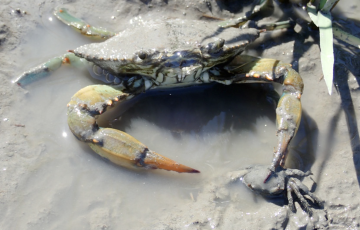crab_edit.png

A blue crab holding an ambushed fiddler crab. Credit: David Johnson, Virginia Institute of Marine Science.
For years, scientists have believed that low tide provided fiddler crabs with a refuge from predatory blue crabs because the fiddlers could crawl around on the mud, out of the water where the danger lurked. But, new observations at a Virginia salt marsh suggest that blue crabs have a few surprises up their claws when it comes to hunting for dinner during low tide. Researchers watched as blue crabs hid out in shallow mud pits filled with sea water and waited, not for the tide to return, but for fiddler crabs to inch their way closer to the edge of the pit.
When one fiddler crab ventured close enough, the blue crab lurched out of the water, grabbed it and began chowing down on its meal. Another blue crab ventured out of its pit and slowly stalked a fiddler crab before snatching it and rushing back to its pit. The scientists noticed leftover fiddler crab claws outside several water-filled mud pits, “like the discarded bones of villagers outside a dragon’s lair,” wrote the scientist.
What makes these observations so extraordinary is that blue crabs typically live, breathe and hunt underwater. Scientists have long believed that these and other swimming crabs almost exclusively feed
when they are completely submerged. While blue crabs have been seen to dash from the water a short distance across land to grab a fiddler crab, that behavior was different from these ambushes far away from the water’s edge. The blue crabs dig the pits themselves or use other crabs’ pits when convenient. They successfully grab fiddler crabs about a third of the time, but sometimes try to steal prey from other crabs. By remaining still, camouflaged by mud in the pit, they also escape the notice of seabirds, their own predators.


